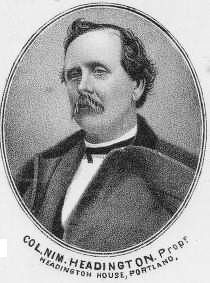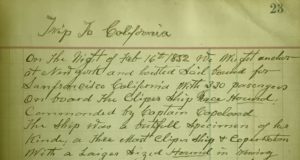Today, the second in a series of blog posts, the transcription the 1852 journal of Nimrod Headington, my fourth great-granduncle. [1]
Nimrod Headington (1827-1913), at the age of 24, set sail from New York in February 1852, bound for San Francisco, California, to join the gold rush and to hopefully make his fortune. The Panama Canal had not been built at that time, so he sailed around the tip of South America to reach the California coast.
Nimrod Headington made a hand-written copy of his 1852 journal for his daughter Thetis O. Tate in 1905. This original hand-written copy stayed in the family and was eventually passed down to Nimrod’s great-great-granddaughter, Karen (Liffring) Hill. Karen, a book editor, died of cancer in 2010, at age 55. During the last two years of her life she transcribed Nimrod’s journal, which documents his travels between February of 1852 and the spring of 1853.
The second installment of Nimrod Headington’s 1852 journal, his “Trip to California.”
MARCH 1852
Sunday, March 1st. This does not appear like a Sabbath day to me. All hands working all day putting up masts and spars and passengers engaged in all kind of amusements—some playing cards, dice, or checkers, while others were reading or singing. It is anything to kill time.
March 2nd. Masts all up again, and we now are under full sail again, heading southeast and running 12 knots an hour in latitude 23°15’. It is quite warm so that a number of the passengers slept on deck.
The next day we struck trade winds again in latitude 20°34’. We had good sailing and smooth sea, which is very acceptable after being in a storm and seasick for so many days.
The next day, the passengers began to grumble about not getting enough to eat. The captain was waited on and notified of the condition of things in the galley kitchen, but he paid no heed to our complaint. So under the circumstances, we formed a board of health, and the next evening, we gathered on deck and proceeded to elect officers, making Captain Copeland president, Mr. John Gomd vice president, and L.D. Shelden secretary, and a committee of six to see that the rations were properly cooked and at the proper time and to see that the decks were kept clean and to report to the doctor if any were sick and needed medicine.
Friday, March 5th. Fair winds and plenty of it. We headed south by east, running 14 knots per hour in latitude 14°12’. The wind continued to blow from the same direction until Sunday, March 7th, when the wind changed to northwest and continued from that direction for four days and nights. This morning finds us in latitude 4°30’. We came in sight of another vessel off our lee bow, which seemed to be heading right toward us and soon came up in plain sight, and when about two miles off, she hoisted her colors. Then up went the Stars and Stripes on our gallant ship. She came nearer and nearer until within speaking distance. Our captain came out with his speaking trumpet and hailed the other ship, saying, “Where are you from? How many days out? Where are you bound for?” And she answered from Calio, “40 days out and bound for Hamburg.” She was a Spanish bark. We gave them three cheers, and our colors dropped, and soon we were out of sight.
The next morning, it rained powerful hard. The wind went down, and the sea was calm all day. The next day, we sighted another ship light astern. There being little or no wind, she could not run up to us. The next morning, she was still in sight. Our captain, being anxious to speak to her, set back sails and at eight o’clock a light breeze struck up. We hoisted our colors, and in a minute the beautiful Stars and Stripes were up on the other ship. This was a beautiful sight to see—an American ship plowing her way through the blue water toward us. She soon came up to us, and our captain lowered a lifeboat and four sailors to row and went on board the other ship. What his business was we did not know, but we thought perhaps as we were then getting very short [on food] and on allowance. And were afraid that we should run out entirely. This ship was The Marian of New York bound for Rio de Janeiro.
March 13th. Today we crossed the equator. Four hours after crossing the line, we had finer winds and good sailing. We came in sight of another ship but not close enough to speak. The winds increased, and we are running at a rapid rate. The passengers are all merry on account of such fine sailing and fine weather. When the captain took the sun’s altitude the next day at noon, we were in latitude 5°29’ south latitude. The winds continued from the same direction. The captain began to be afraid of running ashore. He went aloft and saw on our lee bow land. And he immediately came down and changed our course, and we are now running south by east running 10 knots an hour.
The ship’s doctor—we had on board a Dr. Morgan of Philadelphia—had laid in a fine supply of liquors and had it all marked Castor Oil, pretending that it was for the passengers as medical supplies, but some of the stevedores, whose business it is to get provisions and water out of the hold found out that the vessels were filled with cherry brandy of the best kind, and they broke into the caskets and handed out the liquor by the bucketful, and such a drunken set of sailors probably never was seen on board of a ship. All the stevedores, steward’s cooks, and sailors and some of the passengers were drunk. The next day, the captain found out where they got their liquor, and he sent the stevedores down into the hold and had all the caskets marked Castor Oil hoisted up on deck and then rolled it all into the sea.
The next day was very pleasant, and some of the passengers climbed up into the rigging, and the sailors thought it a good time to have some fun, and they followed them up and tied them fast to the rigging. Some of the passengers were too supple and got down without being caught.
Sunday came, and oh, what a beautiful day! We were then in latitude 18°15’, and while I was eating my breakfast, some one of the passengers cried out, “Breakers ahead!” The mate cursed him and told the man he was a damn fool, but he went aloft to see, and there he saw rock on every side. He was not slow coming down, and he called out, “All hands on deck!” to warn the ship. We ran within 50 feet of two rocks on our starboard side and could see a number more on the larboard side [2]. Had it been in the night, we should have been smashed to pieces and gone to the bottom of the sea, but we got off safely, and we were soon out of sight of those rocks, and I hope we shall not encounter another such school of rocks.
The next day it was calm until evening, when the wind set in from the northwest and blew very hard so that we had to reef sail. [3]
To be continued…
I will post Nimrod’s journal in increments, but not necessarily every week.
[1] Nimrod Headington, the son of Nicholas (1790-1856) and Ruth (Phillips) (1794-1865) Headington, was born in Mt. Vernon, Knox County, Ohio, on 5 August 1827. He married Mary Ann McDonald (1829-1855) in Delaware County, Ohio, in 1849 and they had a son a year later. Nimrod moved to Portland, Jay County, Indiana, by 1860 and a couple years later served in the 34th Indiana Infantry during the Civil War as a Colonel, Lieutenant Colonel, and Major. Nimrod died 7 January 1913 and is buried in Green Park Cemetery, Portland. Nimrod Headington is my fourth great-granduncle, the brother of my fourth great-grandfather, William Headington (1815-1879).
[2] Larboard side: archaic term for port side.
[3] Nimrod Headington’s journal, transcription and photos courtesy of Ross Hill, 2019, used with permission.





2 comments
Wow! Love this! Thanks for sharing it, Karen!
Author
So glad to hear you enjoy it! Thanks for writing!